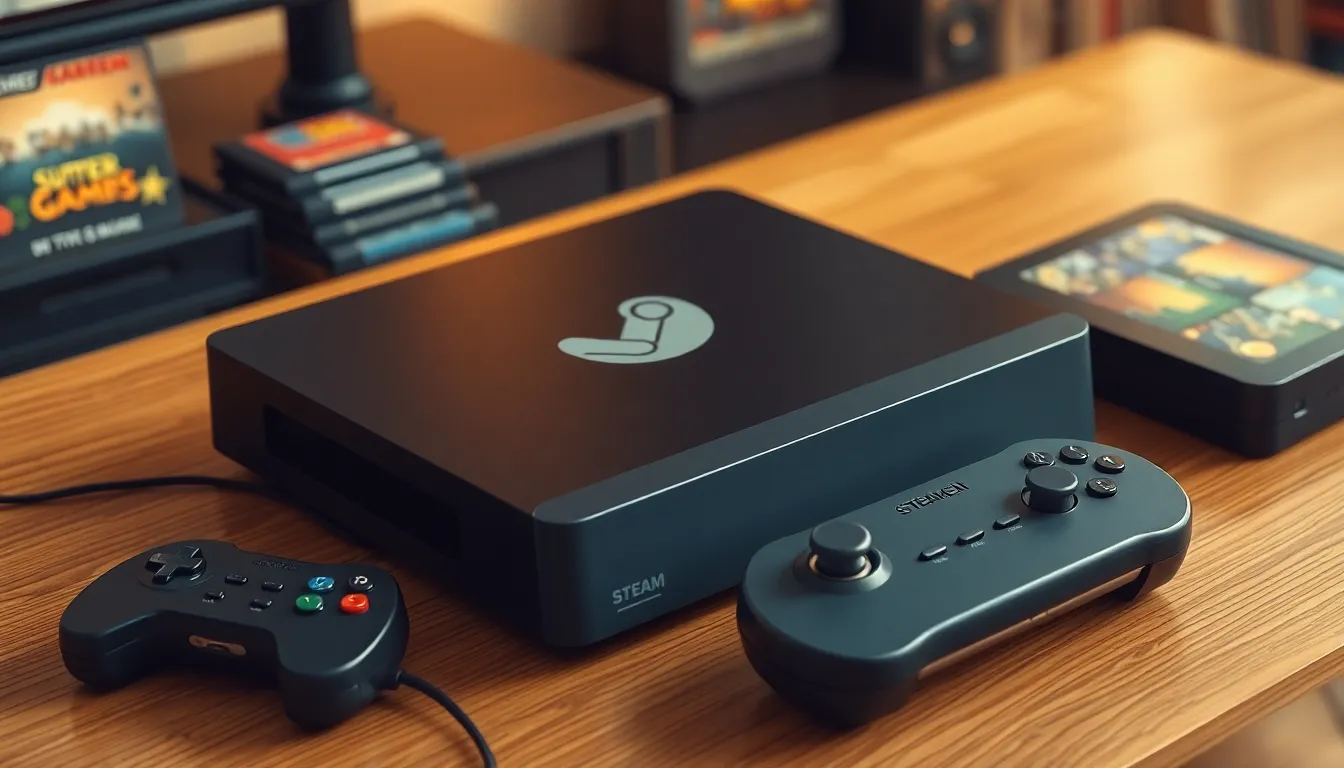Imagine cradling a handheld gaming device that lets you relive your childhood favorites while also playing the latest AAA titles. Enter the Steam Deck, a portable powerhouse that’s not just for modern games. With emulators, it transforms into a nostalgic time machine, allowing gamers to dive into pixelated adventures from consoles long gone.
Whether it’s the thrill of dodging fireballs in classic Mario or the strategic battles of Final Fantasy, the Steam Deck opens up a treasure trove of gaming history. And the best part? It’s as easy as pie—if pie were a complex piece of technology that required a bit of setup. So grab your Deck and prepare to unlock a universe of retro gaming bliss, where every pixel tells a story and every button press brings back memories.
Table of Contents
ToggleOverview of Emulators on Steam Deck
Emulators enhance the Steam Deck’s versatility, allowing users to play a variety of retro and classic games seamlessly. These software applications replicate the hardware of older gaming consoles, enabling access to titles from platforms like NES, SNES, Sega Genesis, and more without the original devices.
Setup for emulators on the Steam Deck remains straightforward. Users can install software such as RetroArch, an all-in-one emulator that supports multiple systems, or standalone emulators tailored to specific consoles. It supports popular formats, including ROMs and ISOs, making game addition easy.
Compatibility ranks high among emulators on the Steam Deck. Many emulators function smoothly, optimizing performance to suit the handheld’s hardware capabilities. Features such as save states, enhanced graphics, and customizable controls enrich the gaming experience, aligning it more closely with modern standards.
Community support thrives, as online resources and forums provide troubleshooting tips and game recommendations. Fellow enthusiasts contribute to development, ensuring regular updates and improved performance across various titles.
Permissions remain crucial when using emulators, as users must own original games to comply with copyright laws. This consideration emphasizes ethical practices while enjoying retro gameplay.
Popular Emulators Available

Several emulators enhance the gaming experience on the Steam Deck, enabling access to classic titles across various platforms. Here’s a look at some popular options.
RetroArch
RetroArch stands out as a multi-platform emulator that supports various gaming systems. It integrates numerous emulators, providing users with a comprehensive library of classic games. Customization options allow players to tweak settings for optimal performance on the Steam Deck. Advanced features include save states and shader support, enhancing the visuals of retro games. Installation remains simple through the Discover Software Center or Flatpak. Engaging with the active community adds to the appeal, as users share tips and game configurations.
Dolphin
Dolphin serves as the leading emulator for Nintendo GameCube and Wii games. It allows players to enjoy titles like Super Smash Bros. and The Legend of Zelda: Twilight Princess in high definition. Compatibility with numerous games ensures a vast library is available on the Steam Deck. Users benefit from enhanced graphics options and customizable controls, enhancing gameplay experience. Installation through Flatpak simplifies the setup process. Community support helps troubleshoot issues and find compatible game settings.
CEMU
CEMU specializes in emulating Nintendo Wii U games, bringing titles like Mario Kart 8 and The Legend of Zelda: Breath of the Wild to the Steam Deck. High-performance graphics capabilities ensure an immersive gaming experience. Frequent updates improve compatibility and game performance, making older titles more accessible. Users can utilize various graphic packs to enhance resolution and visual fidelity. Easy installation through Flatpak makes accessing CEMU straightforward. Sharing insights and configurations with other users fosters a helpful community atmosphere.
Setting Up Emulators on Steam Deck
Emulating classic games on the Steam Deck is straightforward. Users can enjoy a variety of retro titles with a few simple steps.
Installation Process
To install emulators, first access Desktop Mode on your Steam Deck. Users can download the software from official websites or use the Discover app to find popular emulators like RetroArch. For standalone emulators, simply find and install them directly. After installation, users often need to configure the emulator settings to recognize game files. Adding ROMs can involve transferring files via USB or downloading from within the emulator. Familiarity with game file locations aids in smoother gameplay.
Configuration Tips
Configuring an emulator requires a few essential settings adjustments. Select the right graphics settings to match the hardware capabilities of the Steam Deck. Many emulators allow customization of control schemes, enabling users to adjust button mappings for comfort. Activating features like save states enhances gameplay by allowing users to save progress at any point. Regularly check for software updates to maintain compatibility with new games and optimize performance. Engaging with online communities can provide additional insights and troubleshooting support.
Benefits of Using Emulators
Emulators on the Steam Deck provide numerous advantages for gamers looking to relive classic titles. Gamers enjoy access to a diverse array of retro games, spanning multiple generations of consoles. Enhanced graphics and performance often surpass the original hardware, allowing for a superior gaming experience.
Customization options add to the appeal. Players can tailor control schemes to their preferences, improving comfort during play. Features like save states facilitate easy progression through challenging games, removing frustration associated with limited save points.
Community support plays a vital role in optimizing the use of emulators. Access to forums and groups enables users to share tips and tricks for efficient setups and gameplay. Frequent updates from emulator developers contribute to better compatibility and enhanced features, ensuring smooth operation on the Steam Deck.
Cost-effectiveness is another significant benefit. Emulators eliminate the need for purchasing older consoles or physical copies of games, making classic gaming more accessible. Retro gaming also fosters nostalgia, allowing gamers to reconnect with cherished memories and iconic titles.
Exploring various emulators reveals distinct advantages. RetroArch offers an extensive library and multi-platform support, while Dolphin focuses on Nintendo GameCube and Wii titles, providing an immersive experience. CEMU specializes in Wii U games, often delivering high-quality graphics that appeal to fans.
Engaging with the emulator community encourages ongoing learning and fun. Players discover tips for maximizing performance and often share their experiences with others. Each benefit highlights the Steam Deck’s unique capacity to broaden gaming possibilities, making it a versatile choice for both nostalgic and new experiences.
Challenges and Considerations
Emulating classic games on the Steam Deck presents unique challenges. Performance issues can arise due to the varied hardware requirements of older titles. Some games may not run smoothly despite the Steam Deck’s capabilities.
Compatibility with different emulators also poses a challenge. Not all emulators support every game, leading to potential frustrations when users encounter setbacks. Community forums often provide solutions for specific game issues, but troubleshooting can be time-consuming.
Another consideration is the legal implications of using ROMs. Emulators allow access to numerous classic games, yet ownership of original copies is essential to comply with copyright laws. It’s crucial to navigate these legalities carefully.
Battery life can impact gameplay experiences as well. Extended emulator use may drain the Steam Deck’s battery faster than playing modern games. Users should consider monitoring battery usage during extended gaming sessions, especially with more demanding titles.
Storage limitations present an additional hurdle. Retro games, while generally smaller in size, can accumulate quickly and fill available space. Organizing game files and regularly checking available storage space can enhance usability.
Lastly, the setup process requires some technical know-how. Accessing Desktop Mode and downloading the right software can be challenging for less experienced users. Step-by-step guides and community support play a valuable role in easing this process.
The Steam Deck stands out as a powerful handheld device that seamlessly combines modern gaming with retro classics. Its emulator capabilities open up a treasure trove of nostalgic experiences for gamers of all ages. With easy setup processes and a wealth of community support, users can dive into their favorite titles without hassle.
While challenges exist, such as performance issues and legal considerations, the benefits of enhanced graphics, customization, and cost-effectiveness far outweigh them. The Steam Deck not only revitalizes cherished memories but also introduces new players to the rich history of gaming. By embracing emulators, gamers can truly maximize their experience on this innovative platform.








